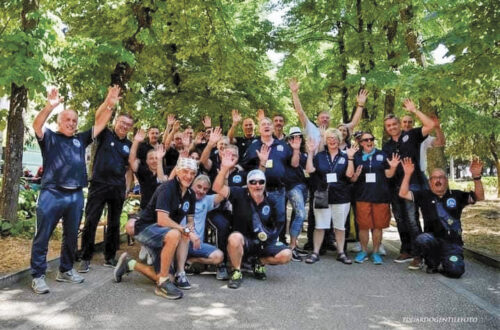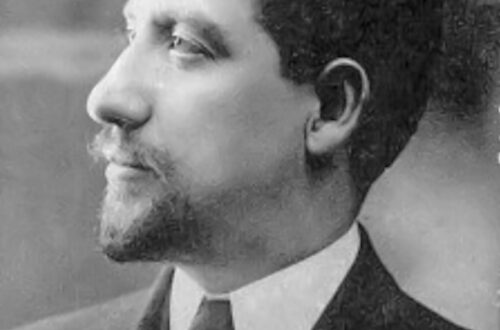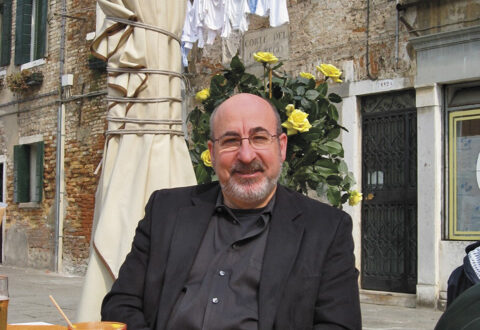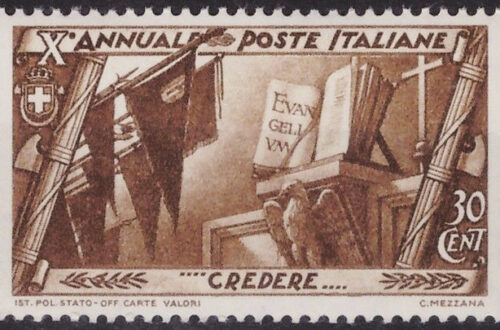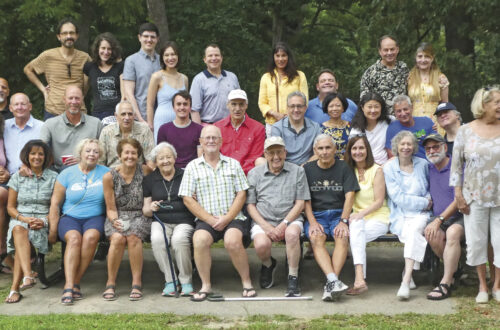-
On Deck: Two Baseball-Themed Events
By Nancy DeSanti
Baseball at the National Postal Museum

The Yogi Berra stamp is
among many items of interest
at the National Postal
Museum’s baseball exhibit.
Credit: USPSAMHS is pleased to offer an opportunity for a guided tour of the National Postal Museum’s baseball exhibit on Sunday afternoon, October 2, 2022. The free tour will be given by the museum’s curator, Daniel A. Piazza, who recently gave the AMHS a virtual talk on Italian stamps (see related article on page 3).
The exhibit will feature stamps and artifacts including those of Joe DiMaggio and Yogi Berra, and it explores the surprising ways that baseball and postal history have been deeply intertwined since the early 20th century. Visitors will see a treasure trove of historically significant game-worn uniforms, jackets, hats, game-used bats, and memorabilia from “America’s pastime.” Artifacts from the stars of the major leagues make this exhibition is a “must” for anyone who loves the game.
Participants are invited to meet at Casa Italiana at 1 p.m. and walk over together to the nearby museum, which is at 2nd & Massachusetts Avenue, N.E., or they can go directly to the museum.
Italian Heritage Night at the Ballpark

This shirt will be given to
those who book special
event tickets to the
Washington Nationals’
Italian Heritage
Night. Credit: mlb.comMeanwhile, on September 27, 2022, the Washington Nationals are holding their first ever Italian Heritage Night, which is a special-ticket event. Thanks to the efforts of World Series-winning General Manager, Mike Rizzo, the Washington Nationals will be recognizing and honoring Italian heritage within their team and the community. Further information is available on the team’s website at https://www.mlb.com/nationals/tickets/specials/italian-heritage.
Please note the following disclaimer on the website:
Celebrate Washington D.C.’s Italian culture as we host our inaugural Italian Heritage Night! Show your Italian and Nationals pride by donning your Nationals-themed Italian Heritage Day promotional item, only available with a Special Event ticket. Full information regarding item pick-up will be emailed to all special ticket event buyers 24 hours prior to the game. This is a Special Ticket Event. To be eligible for any giveaway or experience associated with this promotion, special tickets must be purchased online from the link on this webpage prior to the event. Special tickets will not be available at the Nationals Park box office. Third party purchases will not include access to this event. Ticket brokers are not eligible for this offer. Tickets purchased via this offer shall not be re-sold. This promotion is subject to change without notice. All sales are final. There are no refunds, exchanges or cancellations.
September/October 2022
-
Siamo Una Famiglia

RIP Fr. Charles Zanoni, Life-Long Friend to AMHS
The Society mourns the passing of Father Charles Zanoni on Saturday, August 20, 2022. Father Zanoni was Pastor of Holy Rosary Church when AMHS was founded in June 2000. On the occasion of the Society’s 15th anniversary, he wrote a letter to the Society, stating that he vividly remembers when AMHS President Emeritus, Lucio D’Andrea and his wife Edvige came to him to obtain support for organizing a society of men and women born in the regions of Abruzzo and Molise who live in the Washington, D.C., area. Father Zanoni was happy to give AMHS Holy Rosary Church as a reference to spread our initiative and Casa Italiana as a place for us to meet.
Father Zanoni was bestowed Honorary Membership in the Society. While serving as pastor, he attended many of our events, including the annual AMHS Gala. After he left Holy Rosary Church as pastor in 2005, he never left us because of the communications we send via email, including our Notiziario; and he was a dedicated donor to the AMHS Scholarship Fund. Some of us were fortunate enough to reconnect with Father Zanoni when he returned to Washington for the Centennial Celebration of Holy Rosary Church in December 2013. No doubt several of our members have very fond memories of Father Zanoni. May he rest in peace.
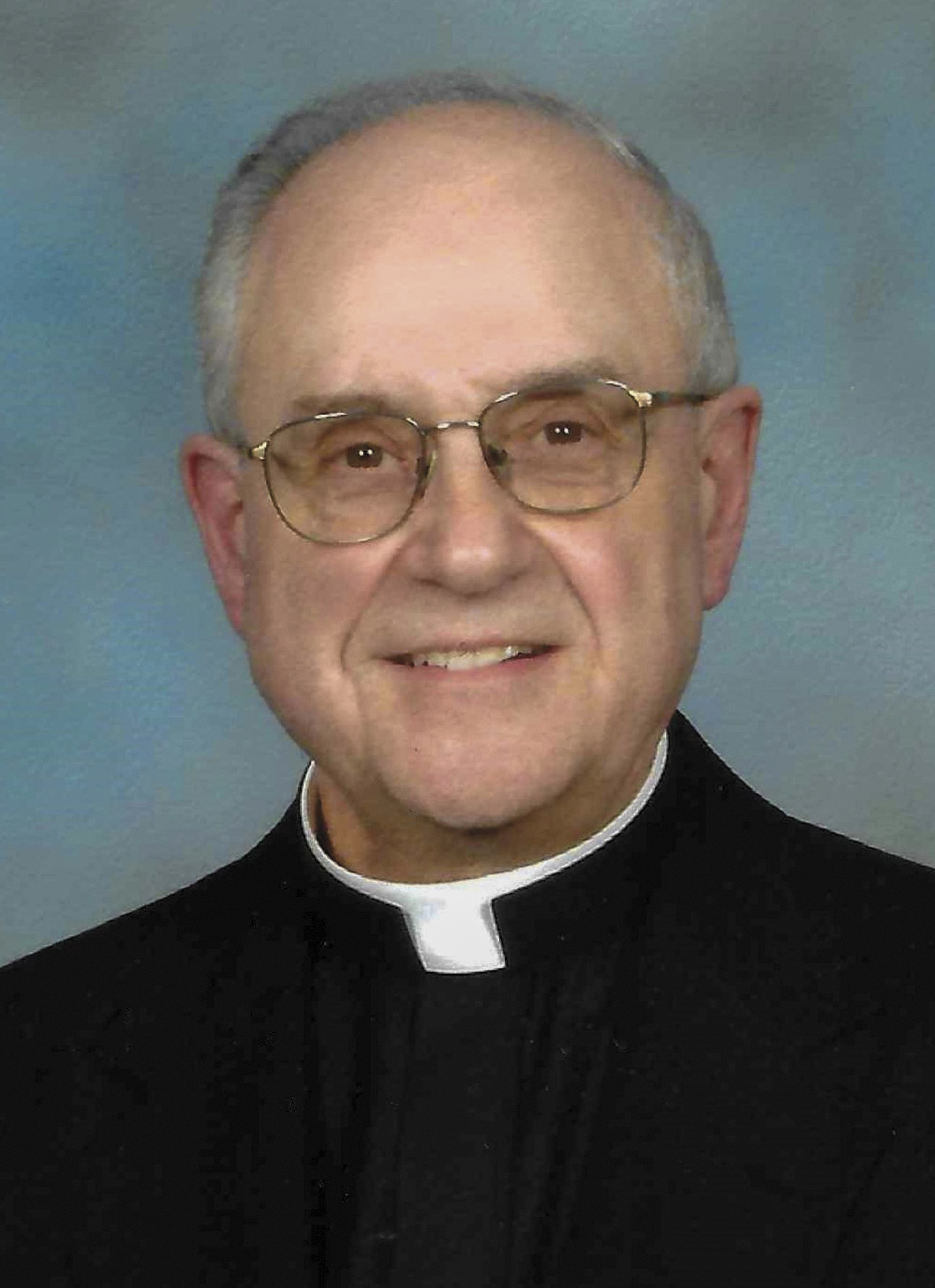
More Wedding Bells

Congratulations to AMHS board member Christopher John Renneker and Dominique Amber Clark, who were married on Saturday, July 23, 2022 at Holy Rosary Church in Washington, D.C., with a reception at The Great Room at historic Savage Mill in Maryland.
Credit: Sam YothersStill More Wedding Bells
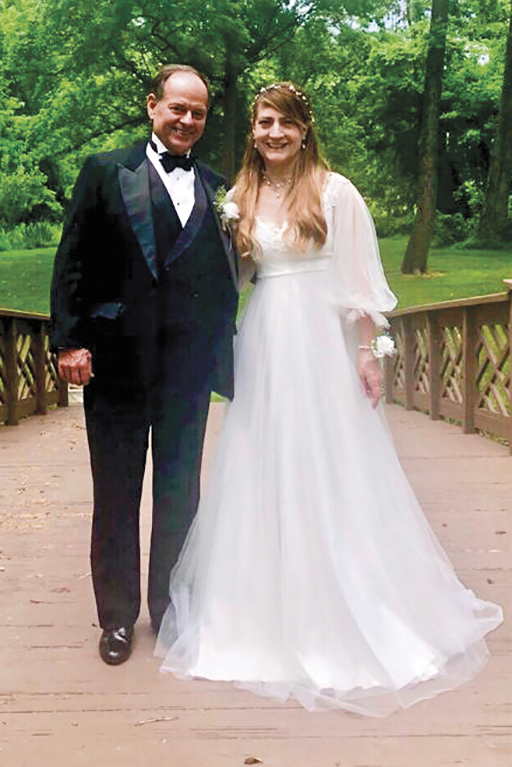
Longtime AMHS member and officer Jeff Clark married Macarena Fernandez, who is also an AMHS member, on June 16, 2022 in Charles Town, West Va. The couple enjoyed an intimate ceremony with Jeff’s and Macarena’s children in attendance.
Credit: Courtesy of Jeff ClarkMike DeBonis Now at Politico

Mike DeBonis has moved to Politico.
Credit: Courtesy of Mike DeBonisAMHS members may recall that in July 2018, Washington Post reporter and fellow member Mike DeBonis gave us a talk on life as a journalist in the nation’s capital. After reporting at the Washington Post for 12 years, including covering Congress since 2015, Mike has now started a new chapter in his career as he has just begun work at Politico, editing the Playbook newsletters.
You can find Mike’s work at https://www.politico.com/blogs/politico-press/2022/07/15/mike-debonis-joins-politico-as-editor-of-playbook-00046039. We wish him good luck in his new endeavor!
Mike is also well-known to many AMHS members through his family ties to our former President Omero Sabatini, and so Mike also traces his roots to the town of Secinaro in the province of L’Aquila in Abruzzo. Mike lives in Washington, D.C., with his wife Dena and their two children.
On To Grad School
In the July/August Notiziario, we reported that AMHS member Joseph Anthony Scafetta III received his B.S. degree in mathematics with a minor in information technology at Marymount University in Arlington, Va. Joey was admitted for graduate studies in the two-year Data Science Certificate program for the Fall 2022 semester at Marymount and began classes on August 29. The AMHS wishes Joey well in his studies.
AMHS Membership
A warm welcome is extended to: Natalie Lui Ducan, Michael and Elizabeth Iademarco, Ann Lamar, Angela Petruzzelli, Erin Powers, Roy Sambuchino, and Daniel Stump.
Birthdays Compleanni a Settembre
Mary Allegrino and Bruno Fusco, September 2; Richard DiBuono and Elissa Padula Sobolewski, September 3; Anthony Phillips, September 4; Sharon Callahan and Lina Marinucci, September 5; Corrado Dal Forno, September 6; Barbara Verdile, Richard Stonestreet, and Maria Marigliano, September 8; Aubrey White, September 5; Roger Galles, September 14; Rose Napolitano, September 18; Theresa Duncan, September 19; Joan Piccariello, September 22; Robert Verdile, September 25; Olimpia Micheli and Father Ezio Marchetto, September 27; David Gadren, Jeffrey Clark, Romeo Sabatini, and Maria LaVerghetta, September 29.Compleanni a Ottobre
Eugene Giammittorio, October 4; Elizabeth DiGregorio and Kirsten Keppel, October 8; John Paolantonio, October 10; Irena DiCarlantonio, October 12; Marco Dorsett, October 14; Guy Caruso, October 21; Sarah Scott, October 22; Antonietta McDonald and Louis Alfano, October 26; Thomas Stallone, October 27; Joseph Scafetta III, October 28; Teresa Forcina, October 29; Erin Powers and Roy Sambuchino, October 31.Anniversaries Anniversari a Settembre
Teresa & Gianpiero Forcina and Sergio & Maria Fresco, September 3; Matthew & Amelia DiFiore, September 16; and James Brady & Mary Anne Re Scherer, September 8.Anniversari a Ottobre
Joseph & Mary Katherine Theis, October 3; Frank & Susan Bonsiero and Robert & Susan Baldassari, October 6; Aldo & Louie Anne D’Ottavio, October 8; Rocco Del Monaco & Eileen Parise, October 9; Alfred & Diana DelGrosso, October 14; Joseph & Rose Ruzzi Sr., October 19; Michael & Antonietta McDonald, October 28; and Salvatore & Anna Maria DiPilla, October 30.Membership Information Category # of Persons
Associate (Couple): 3 x 2 = 6
Associate (Individual): 40
General (Couple): 50 x 2 = 10
General (Individual): 88
Honorary: 10
Scholarship: 2
Student: 7
Total Membership: 254September/October 2022
-
Altino

By Nancy DeSanti
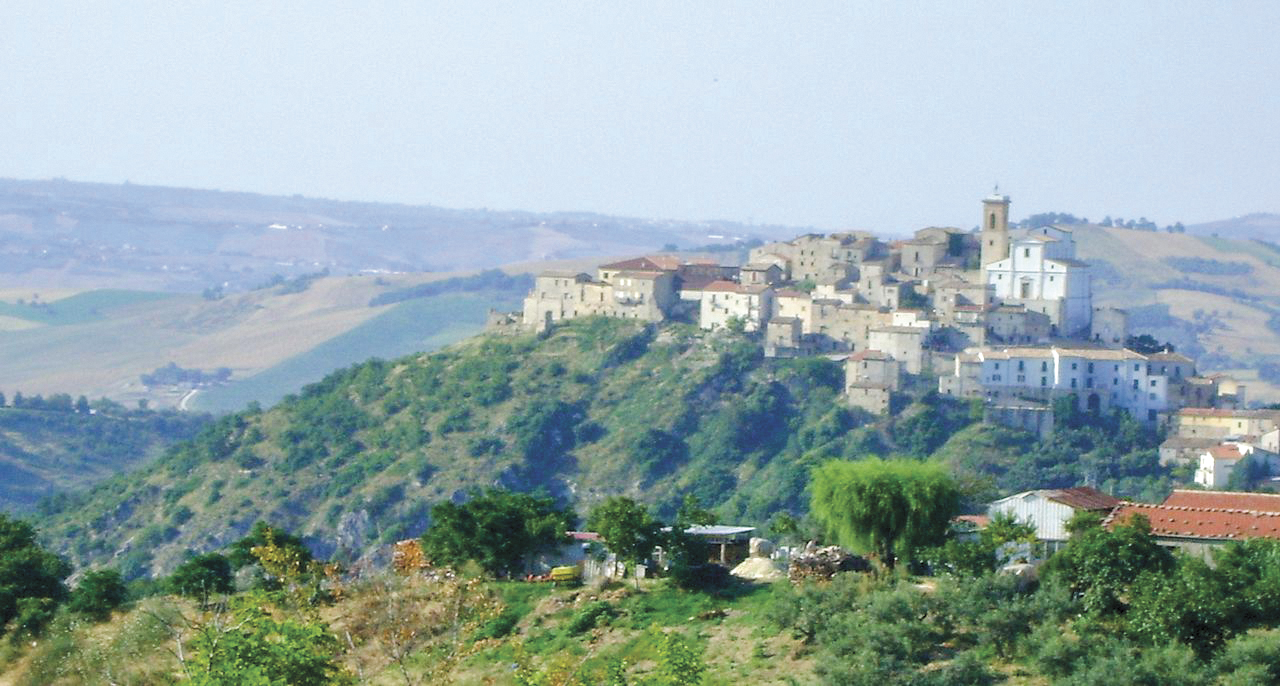
A view of Altino.
Credit: ZitumassinProvince of Chieti, Region of Abruzzo
The small town of Altino is located in the province of Chieti on a rock spur at the foot of Monte Calvario, commanding a scenic view of the valley of the Aventino River. Situated along the Aventino valley, 12 kilometers from Lanciano, Altino rises along a small stream, the Rio Secco, which flows into the Adriatic a few miles away. The valley is richly cultivated with orchards of fruit, grapes and olives. The town has approximately 3,113 inhabitants, known as Altinesi.
Legend has it that Altino was founded in 452 by Venetian refugees fleeing from Attila, who had burned the Roman military port in Altinum (known today as Quarto d’Altino). But in fact, the origin of the village dates back to medieval times. The first mention in historical documents dates back to the 12th century. In the Norman era, Altino was a fief of Bohemond I of Antioch.
In the first half of the 15th century Altino belonged to the Lordship of Raimondo Anichino. The Anichino family held the castle until 1534. Later on, perhaps due to the extinction of the family, Altino came under Alvaro de Grado, Giovanni Vincenzo Crispano, the Tovo, Furia and Paolucci families. In 1861 and 1862, Altino was repeatedly attacked by brigands, and many families moved to Casoli and Chieti.
What to See
- Church of the Madonna delle Grazie, with a fine painting on wood dated 1355
- Parish Church of Santa Maria del Popolo, from the 14th century, with a rock massif
- Church of San Rocco
- Palazzo Sirolli
- Monumental Fountain from 1558
- Nearby Brecciole, a spring of sulphurous waters believed to have healing powers
- Nearby Lake Serranella
Important Dates
- May 15-16 – Feast of Madonna delle Grazie
- July: Historical re-enactment of threshing, with a parade of rural tools of the past
- Last weekend in August – Festival del Peperone Dolce di Altino e dell’Oasi di Serranella
- September 26-27 – Feast of Saints Cosmo and Damiano.
Italiano

Tradotto da Ennio Di Tullio
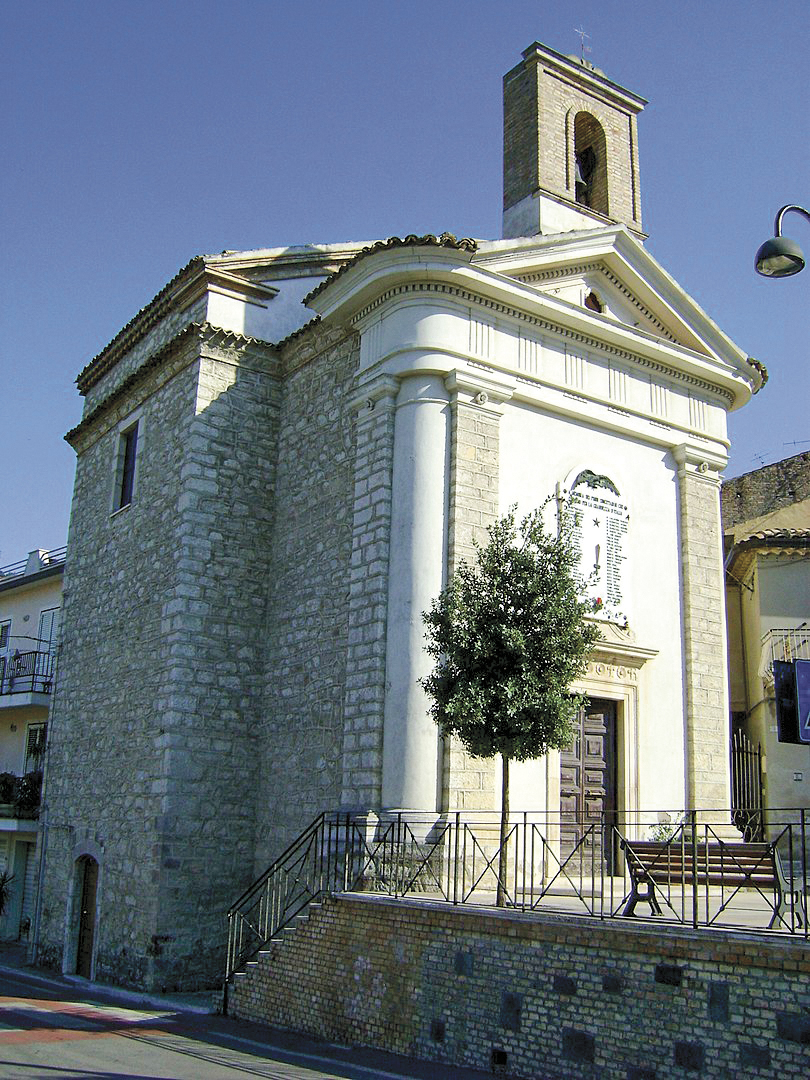
La chiesa di San Rocco.
Credit: ZitumassinProvincia di Chieti, Regione Abruzzo
Il piccolo comune di Altino è situato in provincia di Chieti su uno sperone roccioso ai piedi del Monte Calvario, dominando una vista panoramica sulla valle del fiume Aventino. La valle è riccamente coltivata a frutteti, frutti, uva e olivi. Il paese conta circa 3.113 abitanti, detti Altinesi.
La leggenda narra che Altino sia stata fondata nel 452 da profughi veneziani in fuga da Attila, che avevano incendiato il porto militare romano di Altinum (oggi noto come Quarto d’Altino). Ma in realtà l’origine del paese risale al medioevo. La prima menzione nei documenti storici risale al XII secolo. In epoca normanna Altino fu feudo di Boemondo I di Antiochia.
Nella prima metà del XV secolo Altino appartenne alla Signoria di Raimondo Anichino. La famiglia Anichino tenne il castello fino al 1534. Successivamente, forse per l’estinzione della famiglia, Altino passò sotto Alvaro de Grado, Giovanni Vincenzo Crispano, i Tovo, Furia e Paolucci. Nel 1861 e nel 1862 Altino fu ripetutamente assalito dai briganti e molte famiglie si trasferirono a Casoli e a Chieti.
Situato lungo la valle dell’Aventino, a 12 chilometri da Lanciano, Altino è adagiato su un crinale montuoso a sinistra del Sangro e a destra del fiume Aventino. Altino sorge lungo un piccolo ruscello, il Rio Secco, che sfocia nell’Adriatico a pochi chilometri di distanza. Da questo piccolo paese si può godere di una vista incredibile. Il fertile territorio è ricoperto da vigneti e uliveti, e in pianura vi è una ricca produzione di frutta.
Le attrazioni del luogo:
- Chiesa della Madonna delle Grazie, con pregevole dipinto su tavola del 1355
- Chiesa Parrocchiale di Santa Maria del Popolo, del XIV secolo, con massiccio roccioso
- Chiesa di San Rocco
- Palazzo Sirolli
- Fontana Monumentale del 1558
- Nelle vicinanze di Brecciole, sorgente di acque sulfuree ritenute dotate di poteri curativi
- Nelle vicinanze Lago Serranella
Date da ricordare:
- 15-16 maggio – Festa della Madonna delle Grazie
- Luglio: Rievocazione storica della trebbiatura, con sfilata di attrezzi rurali del passato
- Ultimo fine settimana di agosto – Sagra del Peperone Dolce di Altino e dell’Oasi di Serranella
- 26-27 settembre – Festa dei Santi Cosmo e Damiano.
Sources: https://en.wikipedia.org/wiki/Altino,_Abruzzo
https://www.italyheritage.com/regions/abruzzo/chieti/altino.htm
https://www.yesabruzzo.com/altinoSeptember/October 2022
-
Fornelli

By Nancy DeSanti
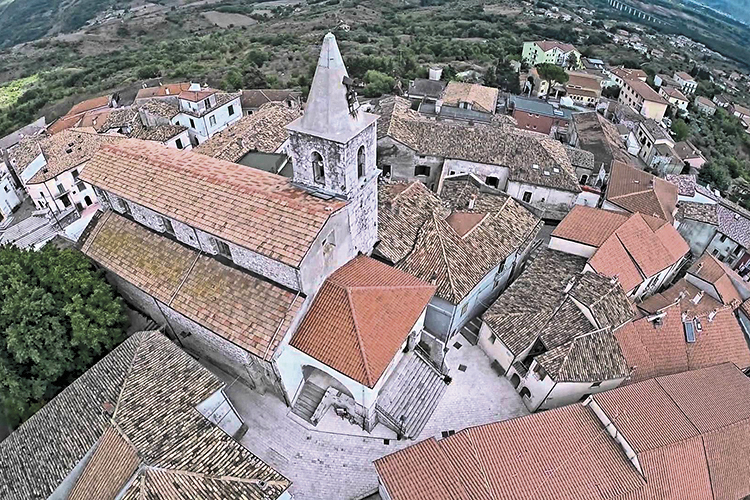
An aerial view of Fornelli.
Credit: italian-traditions.comProvince of Isernia, Region of Molise
The town of Fornelli is located about 8 kilometers west of Isernia. The town rises near the Vardia River, on top of a hill facing Colle Ginestra where there are ruins of an ancient Italic acropolis. It has approximately 2,014 inhabitants, known as Fornellesi.
Annunziata Lombardi D’Alesandro, the mother of Nancy Pelosi, the Speaker of the U.S. House of Representatives, was born in Fornelli in 1909.
Fornelli was first recorded in the 10th century as the location of one of the castles erected to defend the monastery of San Vincenzo al Volturno. The town’s name most likely derives from the presence in the area of a large oven (forno) for the working of metals and to bake clay bricks used for construction works. The original name of Fornello was changed into Fornelli in the 18th century.
Fornelli is known as the “The Town of Seven Towers.” The ancient town is enclosed by city walls that are some of the best preserved in Molise. The main sights are the Church of St. Michael the Archangel, the Church of St. Peter the Martyr, the Baronial Palace and the Summer Fountain.
The hill on which the mother church stands suggests that it has seen the passage and the ruling of the Longobards. In the highest part of the village, there is the baronial palace that repeats the system of the ancient Lombard castle. The seven towers incorporated in the defensive walls are of the Norman and Angevin period. The main door of access to the historical center was equipped with a drawbridge that rose on the moat.
During World War II, on October 4, 1942, the Germans sought to suppress the resistance in the village by executing the mayor and five other citizens, for which Fornelli was given a medal for military valor.
Fornelli is surrounded by olive trees and produces a fruity and light oil. Among the local dishes are taccunell e fasciuel, a paste without eggs, cut into squares and seasoned with sautéed olive oil, garlic and beans; sciur c pastiera, a tart rice cooked in milk prepared at Easter time; cecrchiata, balls of sweet paste with honey prepared at Christmas time; ’r sciusc, bread dough and potatoes, fried and sprinkled with sugar; and coccia, batter-fried zucchini flowers.
Since her mother was born in Fornelli, Nancy Pelosi visited the town in early July 2022. Pelosi’s maternal grandfather, Nicola Lombardi, born in 1878, immigrated to America with his daughter Annunziata, Pelosi’s mother, who was just three years old.
After visiting Fornelli, Pelosi visited her father’s ancestral home in Montenerodomo, Abruzzo. It was from Montenerodomo where, in 1891, her paternal grandfather, Tommaso Fedele D’Alessandro, born in 1868, immigrated to America. He was the son of Giuseppe, a farmer, and Lucia Rossi.
What to See
- Palazzo Vecchio
- The Baronial palace, built on the castle walls at the door of Umberto I square, has two circular Norman incorporated towers with the main façade
- Church of San Michele Arcangelo, consecrated in 1746, with a statue of San Michele and three paintings of the 18th century recently restored
- Church of St. Peter the Martyr, located in the square on which is located the fountain dedicated to Summer, and a replica of the sculpture that the French Le Mathurin Moreau presented to the World’s Fair in Paris in 1855
Important Dates
- A week before Easter – the “tuzza” game played with eggs
- August – Giornate al borgo, celebrating the medieval tradition
- October – Vintage festival.
Italiano

Tradotto da Ennio Di Tullio
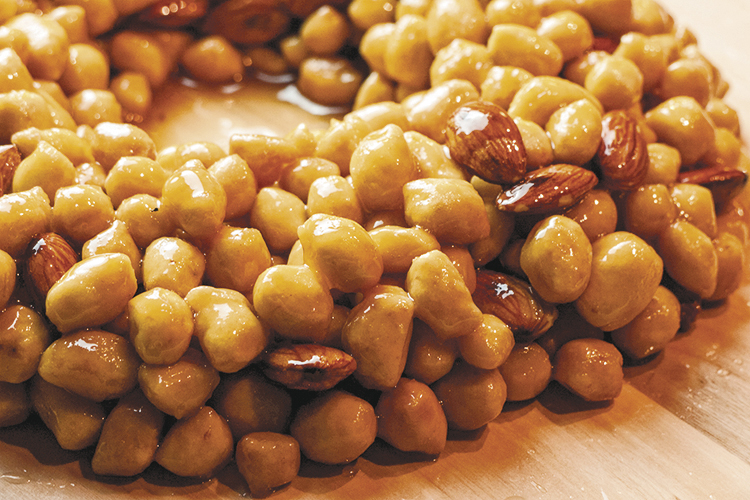
Cecrchiata, balls of sweet paste with honey prepared at Christmas time. Credit: italian-traditions.com 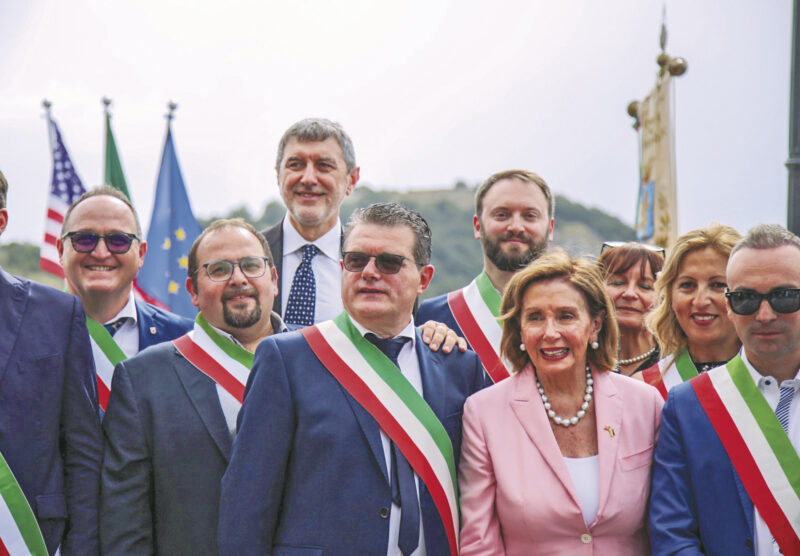
U.S. House Speaker Nancy Pelosi visited her mother’s birthplace Fornelli in July 2022. Credit: abruzzoweb.it Provincia di Isernia, Regione Molise
Il comune di Fornelli si trova a circa 8 chilometri a ovest di Isernia. Il paese sorge nei pressi del fiume Vardia, sulla sommità di un colle prospiciente il Colle Ginestra dove si trovano i resti di un’antica acropoli italica. Conta circa 2.014 abitanti, detti Fornellesi.
Annunziata Lombardi D’Alesandro, madre di Nancy Pelosi, Presidente della Camera dei Rappresentanti degli Stati Uniti, è nata a Fornelli nel 1909.
Fornelli è documentato per la prima volta nel X secolo come sede di uno dei castelli eretti a difesa del monastero di San Vincenzo al Volturno. Il nome del paese deriva molto probabilmente dalla presenza nell’area di un grande forno (oven) per la lavorazione dei metalli e per la cottura di mattoni di argilla utilizzati per i lavori di costruzione. Il nome originario di Fornello fu mutato in Fornelli nel XVIII secolo.
Fornelli è conosciuta come la “Città delle Sette Torri”. Il borgo antico è racchiuso da una cinta muraria tra le meglio conservate del Molise. Le principali attrazioni sono la Chiesa di San Michele Arcangelo, la Chiesa di San Pietro Martire, il Palazzo Baronale e la Fontana d’Estate.
Il colle su cui sorge la chiesa madre fa pensare che abbia visto il passaggio e il governo dei Longobardi. Nella parte più alta del paese si trova il palazzo baronale che ripete il sistema dell’antico castello longobardo. Di epoca normanna e angioina sono le sette torri inglobate nelle mura difensive. La porta principale di accesso al centro storico era dotata di un ponte levatoio che sorgeva sul fossato.
Durante la seconda guerra mondiale, il 4 ottobre 1942, i tedeschi, reprimendo la resistenza del paese, giustiziarono il sindaco e altri cinque cittadini, per i quali Fornelli ricevette una medaglia al valor militare.
Fornelli è circondato da ulivi e produce un olio fruttato e leggero. Tra i piatti locali ci sono il taccunell e fasciuel, una pasta senza uova, tagliata a quadrotti e condita con un soffritto in olio d’oliva, aglio e fagioli; la sciur c pastiera, una crostata di riso cotto nel latte preparata nel periodo pasquale; ceccchiata, palline di pasta dolce al miele preparate nel periodo natalizio; ‘r sciosc, pasta di pane e patate, fritte e spolverate di zucchero; e coccia, fiori di zucca fritti in pastella.
Poiché la madre di Nancy Pelosi nacque a Fornelli, il Speaker ha fatto visita al paese ai primi di luglio. Il nonno materno di Pelosi, Nicola Lombardi, classe 1878, immigrò in America con la figlia Annunziata, la madre di Speaker Pelosi, che aveva appena tre anni.
Dopo aver visitato Fornelli, Pelosi ha visitato la casa ancestrale del padre a Montenerodomo, in Abruzzo. Era da Montenerodomo dove, nel 1891, suo nonno paterno, Tommaso Fedele D’Alessandro, nacque nel 1868, immigrò in America. Era figlio di Giuseppe, contadino, e di Lucia Rossi.
Le attrazioni del luogo:
- Palazzo Vecchio
- Il palazzo Baronale, edificato sulle mura castellane alla porta di piazza Umberto I, presenta due torri circolari inglobate normanne con la facciata principale
- Chiesa di San Michele Arcangelo, consacrata nel 1746, con una statua di San Michele e tre tele del ‘700 recentemente restaurate
- Chiesa di San Pietro Martire, situata nella piazza su cui si trova la fontana dedicata all’Estate, e una replica della scultura che il francese Le Mathurin Moreau presentò all’Esposizione Universale di Parigi nel 1855
Date da ricordare:
- Una settimana prima di Pasqua – il gioco della “tuzza” con le uova
- Agosto – Giornate al borgo, celebrando la tradizione medievale
- Ottobre – Festa della vendemmia.
Sources: https://en.wikipedia.org/wiki/Fornelli
https://www.italyheritage.com/regions/molise/province-isernia/fornelli.htm
https://italian-traditions.com/fornelli-the-country-of-the-seven-towers/September/October 2022
-
Art Expert to Lecture on Four Masters of the Venetian Renaissance
By Nancy DeSanti
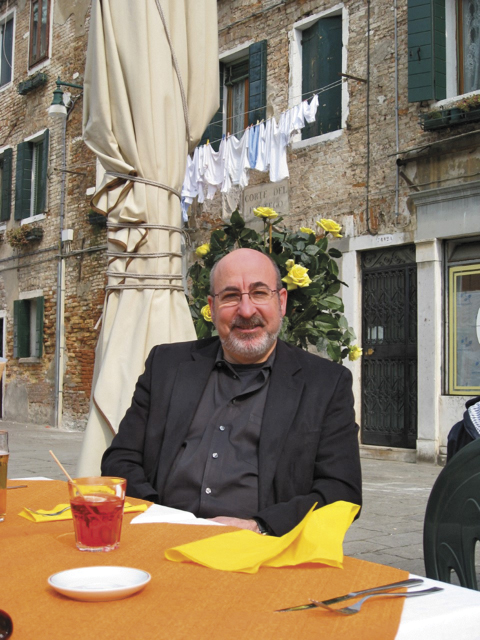
Eric Denker in Italy.
Credit: Courtesy of Eric Denker
AMHS is pleased to announce that our next in-person program will feature distinguished art expert, Dr. Eric Denker, who until recently was the Senior Lecturer of the National Gallery of Art. The luncheon meeting will take place in Casa Italiana on Sunday, September 18, 2022, at 1 p.m.
The program is being co-sponsored by the Casa Italiana Sociocultural Center and the Casa Italiana Language School.
Dr. Denker’s topic will be the “Four Titans of the Venetian Renaissance: Bellini, Giorgione, Titian and Tintoretto.” He will be dedicating his lecture to the memory of our late Holy Rosary parishioner Diego D’Ambrosio.
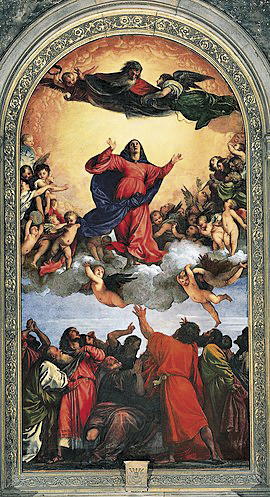
The Assumption of the Virgin, popularly known as the Assunta by Titian will be among the works discussed at the September 18 meeting.
Credit: WikipediaFor many years, Dr. Denker was the Head of Adult Programming and the Senior Lecturer at the National Gallery of Art. He and his staff prepared and delivered talks on special exhibitions and the permanent collection to diverse and specialized adult audiences. In particular, he was responsible for designing programs and offering gallery talks on European and American paintings, sculpture, prints and drawings.
From 1998 to 2006, Dr. Denker also served jointly as the Curator of Prints and Drawings at the Corcoran Gallery of Art, overseeing the permanent collection and coordinating an active exhibition schedule that included the catalogue and show of “Whistler and his Circle in Venice.”
He attended Dickinson College in Carlisle, Pa., and received his doctorate from the University of Virginia. In addition to teaching 19th century art as an adjunct professor for both Georgetown University and Cornell University, Dr. Denker frequently lectures in Europe for the Smithsonian Institution and for the Scuola Internazionale di Grafica in Venice.
He is the co-author, with Judith Martin (also known as Miss Manners), of the 2007 book “No Vulgar Hotel: The Desire and Pursuit of Venice,” exploring the contemporary visitor’s passions for the unique lagoon city. Dr. Denker is the author of seven books and catalogues, and his two most recent works are “Reflections and Undercurrents: Ernest Roth and Printmaking in Venice, 1900-1940” and “Two for the Road: Ernest Roth and Andre Smith in Europe, 1912-1930.” He also is the author of numerous articles for guidebooks about Venice and Italy.
Prior to the lecture, a delicious lunch will be catered by Osteria da Nino. Space is limited, so if you are interested in attending, please register as soon as possible.
September/October 2022
